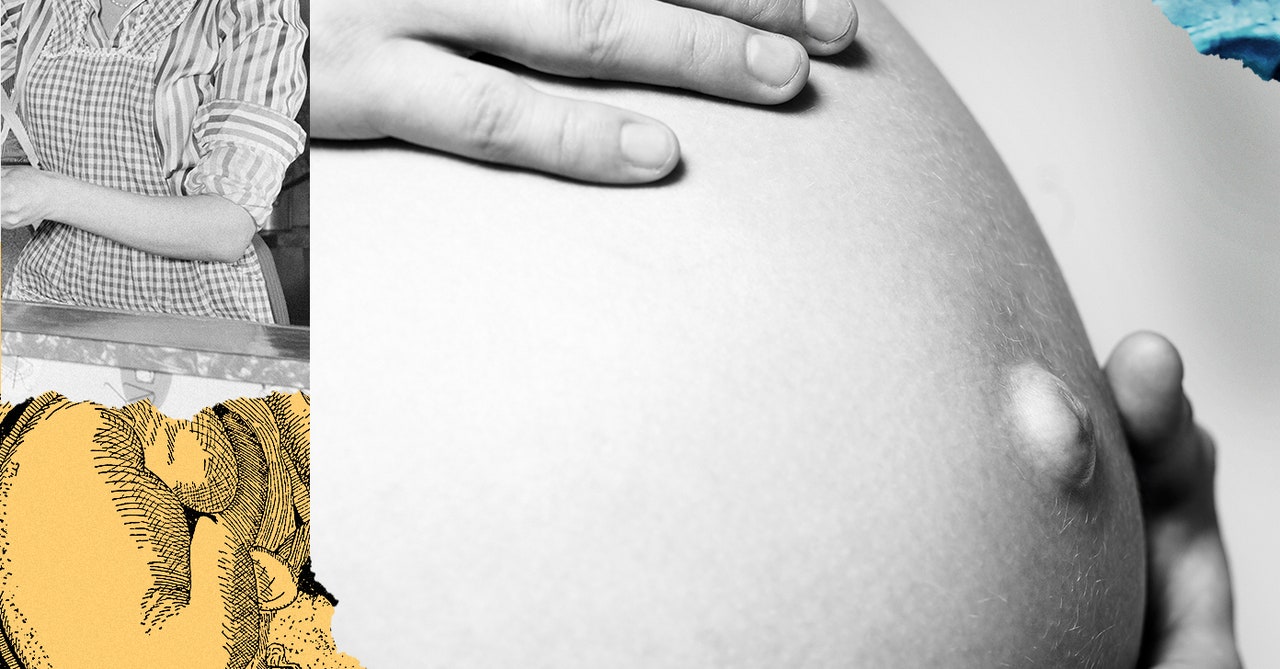
Karl, a PhD and lecturer at MIT, gave birth to both of his children—and despite being the one with the baby bump, he was routinely asked to wait outside while the nurses attended to his (not pregnant) wife. People were unable, he says, to see both a man and a pregnant body; as a result, Karl became a “fat man” rather than a pregnant person. Despite being assigned female at birth (AFAB) and possessing a uterus and glands for lactating, Karl was not—in the eyes of even the medical staff—the mother. Karl considered himself a PaPa; other transgender parents choose more androgynous terms, largely because of the way motherhood has been construed. At best, says Karl, unconventional pregnant parents cause “total gender confusion” even among medical practitioners, but at worst it results in trauma, violence, and harm, in trans men failing to get emergency care during miscarriages, in trans women being treated as pedophiles, and in nonbinary identities being entirely erased.
And yet woman and mother are not, nor have they ever been, synonymous. In fact, neither term has any objective reality at all.
Motherhood, like gender, is a social construct; “it exists because humans agree that it exists.” We create constructs as a means of ordering the world and attempting to control it. They are useful for organizing our thoughts; they become extremely dangerous when we mistake them for reality. Some commentators go so far as to suggest that a trans woman’s pregnancy “inverts” and warps “immutable biological realities.” But motherhood is not immutable, and it is not (necessarily or entirely) biological. In recent decades, scientific technology has come closer than ever to providing fertility to all, from those who struggle with infertility due to conditions like endometriosis or low gamete count to those born with Mayer-Rokitansky-Küster-Hauser (MRKH) syndrome, a rare disorder wherein AFAB women are born without a womb or upper two-thirds of the birth canal.
The concept of “motherhood” must be actively decoupled from its exclusive connection to “womanhood” or we risk devolving into a society that penalizes, imprisons, or commits violence against would-be parents or their children. We built this term and imbued it with meaning, and we can likewise change it, and perhaps divest it of its divinity and its demons.
Adrienne Rich, a poet and essayist, once described “two strands” of motherhood. One is an experience, and the other is a political institution in which “all women are seen primarily as mothers; all mothers are expected to experience motherhood unambivalently and in accordance with patriarchal values; and the ‘nonmothering’ woman is seen as deviant.” These restrictive assumptions do more than limit the opportunities for women; they limit access to health care for those who would become mothers but who do not fit the traditional concept of motherhood. (The recent Supreme Court decision draft concerning Roe vs. Wade makes these ommissions even more glaring, as transgender people with uteruses are continually left out of discussions about reproductive rights.)
Today’s gender-biased assumptions about motherhood have been largely inherited from the rise of the middle class. Among the poorer classes, men, women, and sometimes children worked to sustain the family; among wealthy or aristocratic women, nurses and governesses frequently took on the childcare. But affluent 19-century families, who could afford leisure, needed to have only one parent leave the house for work, and it became a mark of pride if a man could keep his wife at home. The new middle class fused the woman, wife, and mother into a single social category. The image of the submissive housewife and mother was reinforced in the June Cleaver tropes of the 1950s and ’60s. According to Pew time-use studies, in 1965 dads spent only 2.5 hours a week taking care of their children. That was a woman’s work, even if “motherhood” as a social role for women was a recent invention.
The social constructs surrounding motherhood have always limited the experience to very specific and patriarchally sanctioned groups. Class, education level, and race have all been used at different times to deny the right to mother. In the 20th century, more than 60,000 people (largely women of color, disabled persons, and those with lower incomes) were sterilized against their will in the United States. In California, female prisoners were forcibly sterilized as late as 2010. And Immigration and Customs Enforcement teams have been accused of coercive sterilization of detainees in the past five years. All of these procedures were performed on people who possessed the reproductive organs for giving birth and were considered “women” by those who took their organs away. For all the emphasis on motherhood belonging only to people who have two X chromosomes and were assigned female at birth, there are those ready to forcibly take that right away when it suits political ends. It’s clear, therefore, that no term is immutable.
Similarly, trans women are often excluded from the category of motherhood in a variety of ways. Some have been denied the term “mother” by their children and even by court systems, but the threats to transgender parenthood don’t stop there. As Mya Byrne, an American singer-songwriter, actor, and trans activist, explains, trans women are thought of as “problematic” parents by heteronormative society. They have been presented as “unsafe” around children through deeply sexist and genderist rhetoric [Trigger warning: Linked transcript contains abusive language toward transgender persons]. “If a child came to my door, I would take it in and raise it,” Mya tells me; “If you adopt, they are your own kids. [Queer people] create family. We create parenting. And whether or not we reproduce through gestation, we can be parents.”
